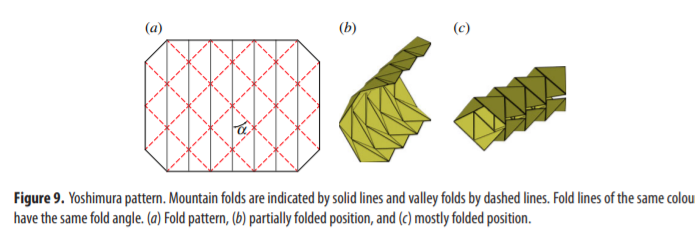
The Muira Ori Pattern is a simple grid of folding that follows two key rules: the horizontal folds are straight and the vertical folds are diagonal or zigzag. This characteristic means there can be a smooth deployabilit for this structure and that at the vertices of the folds (in architectural, the connections), the intersections displace on another, avoiding friction and stress between them. This means that with the use of hinges, the material would not undergo much less stress than if the two key rules were not followed.


The Yoshimura pattern follows a similar ruling, except there are only vertical folds and diagonal folds to form a diamond pattern. This creates a significant stiffness in the axial direction.

Case Study: Origami Dome
A project created by N. Sugiura, Y. Nakamura, H. Tagawa, T. Uno, and S. Okazaki of the Mukogawa Women’s University for the 4th International Conference of Archi-cultural Interactions through the Silk Road examined how the Yoshimura pattern can be a solid point of reference for structural legitimacy. Their Origami Dome was made of a propylene cardboard of varying thickness that created a small space for people to sit and relax.




References
Ahmed, S., Kamel, A., & Mahmoud, W. (2020). Methodology for using origami in designing deployable shelters. Journal of Design Sciences and Applied Arts, 1(2), 20–37. https://doi.org/10.21608/jdsaa.2020.28469.1016
Doroftei, I. A., Bujoreanu, C., & Doroftei, I. (2018). An overview on the applications of mechanisms in architecture. part II: Foldable Plate structures. IOP Conference Series: Materials Science and Engineering, 444, 052019. https://doi.org/10.1088/1757-899x/444/5/052019
Evans, T. A., Lang, R. J., Magleby, S. P., & Howell, L. L. (2015). Rigidly foldable origami gadgets and tessellations. Royal Society Open Science, 2(9), 150067. https://doi.org/10.1098/rsos.150067
YiğitNergiz, & SeçkinYavuz. (2004). Industrial product design by using two-dimensional material in the context of origamicstructure and integrity(dissertation).
Megahed, N. A. (2017). Origami folding and its potential for architecture students. The Design Journal, 20(2), 279–297. https://doi.org/10.1080/14606925.2017.1270511
Sugiura, N., Nakamura, Y., Tagawa, H., Uno, T., & Okazaki, S. (2017). DESIGN AND FABRICATION OF ORIGAMI DOME. In Archi-cultural interactions through the Silk Road: 4th International Conference, MukogawaWomen’s University, nishinomiya, Japan, July 16-18, 2016, Selected papers(pp. 202–205). Nishinomiya; MukogawaWomen’s University Press. Retrieved 11AD.
Leave a comment